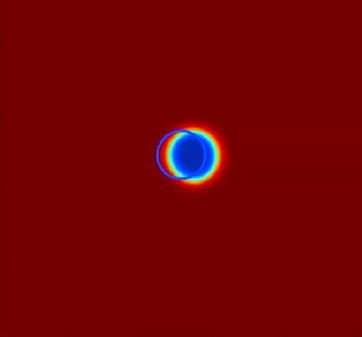Physicists find properties of magnetic soliton of interest for brain-inspired computing

A team of physicists has uncovered properties of a category of magnetic waves relevant to the development of neuromorphic computing—an artificial intelligence system that seeks to mimic human-brain function.
"As we continue to pioneer novel computing paradigms, understanding the characteristics and promise of their building blocks is essential," explains Andrew Kent, a physicist at New York University who led the research team. "Our findings reveal how one of these components act, which is the next step in helping realize their potential."
The research, which appears in the journal Scientific Reports, also included scientists from the University of Barcelona and the Institute of Materials Science of Barcelona. Its lead authors were Jinting Hang, an NYU physics graduate student, and Christian Hahn, an NYU postdoctoral fellow who presently works at Physikalisch-Technische Bundesanstalt (PTB) in Germany.
Kent and his colleagues previously imaged magnetic solitons, a then-undetected magnetic wave, which offer the possibility to serve as an energy-efficient means to transfer data in consumer electronics.
Solitons, or solitary waves, were theorized to occur in magnets in the 1970s. They form because of a delicate balance of magnetic forces—much like water waves can form a tsunami. These magnetic waves can potentially be harnessed to transmit data in magnetic circuits in a way that is far more energy efficient than current methods that involve moving electrical charge.
In the Scientific Reports study, the scientists examined a specific type of soliton—a magnetic droplet, which is dynamic; the magnetic waves that make up this kind of soliton oscillate rapidly.
In their work, the researchers unearthed some of these droplet solitons' functionality—specifically, how far or long solitons can propagate without dissipating and how long they take to form.
"This category of solitons may be important to the development of brain-inspired computing systems," explains Kent. "For example, they function as oscillators with a memory and thus mimic some characteristics of neurons."
A video of this process may be viewed here. It shows a magnetic droplet orbiting an electrical contact to a thin magnetic layer. The perimeter of the contact is shown by the blue circle. The magnetic moments in the droplet oscillate very rapidly compared to the time it takes for the droplet to complete an orbit. Like water drops, a magnetic droplet will evaporate, or disappear, when no longer sustained by an electrical current.
More information: Jinting Hang et al, Generation and annihilation time of magnetic droplet solitons, Scientific Reports (2018). DOI: 10.1038/s41598-018-25134-z
Journal information: Scientific Reports
Provided by New York University
















